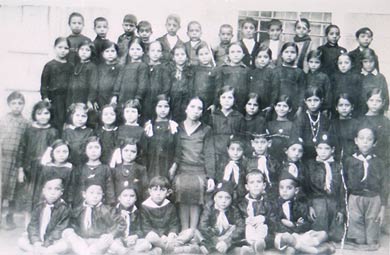The collected testimonies inform that the first school building was where now there is Piazza Monumento, “a mesu bidda” (in the past this place was called in that way).
It is remembered as a building not suitable to give hospitality to students because of its conditions.
On October 7th, 1929 after a flood, it was completely destroyed. After that, the municipality started to build another one. After having expropriated a wide part of territory to one of the greatest owners of the town, started in 1931 the works and they finished quickly.
On 4 May 1932, the school was called “Giuseppe Garibaldi” in honour of this famous Italian general. The school is in the square that has its same name and it is still working.
The classes
On September 4th, 1925 the institution of the class 4th of primary school (already instituted in 1919, but abolished in 1923 because of the few students) was asked again to the provincial education authority.
Until then, so, the children had to attend the classes 4th and 5th in the school of Decimomannu. They went there by foot, fording the Rio Mannu thanks to a boatman who stopped close to the river.
Few pupils formed the classes, more or less 10-12 schoolchildren. There was not scholastic obligation, so many children, above all the poor ones, started to work very soon without having the possibility to study.
The teacher
The teaching and the education of the children were delegated to just a teacher, who followed them from the 1st to the 5th class. The collected testimonies remember the severity with which he did his job, but also the reliability and the good qualification.
Sometimes the children were punished, making them to kneel down on kitchen salt or chickpeas, but also with blows, with a stick, on their hands.
Teaching materials
The pupils usually used two big exercise book, one for the fair copy (it had to be left at school) and one for the rough copy (it was taken at home). They had pencils, nib, inkpot and books too. Who had money bought all the materials but/while the poor children received everything by the scholastic patronage.
The lessons
The lessons started in September and finished in June. The pupils had to go to school both in the morning and in the afternoon, so on Tuesday was allowed a day off. Every month was assigned as homework a monthly composition.
Curiosities
The pupils wore a black pinafore, on which was sewn a velvet red strip to indicate the school year: so a strip for the 1st year at school, 2 strips for the second class and so on until the 5th.

A primary mixed class during the period of the fascist dictatorship. We can observe the “balilla” clothes of the boys in the first row.
